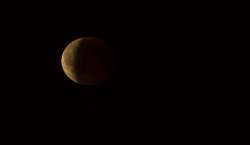Lunar Eclipse 2021: Longest partial Chandra Grahan in 580 years today | How and where to watch
The lunar eclipse, the last of 2021, will be the longest since the 15th century.

The longest partial lunar eclipse in 580 years will occur today (19 November) and will be visible from parts of Northeast India. The lunar eclipse, the last of 2021, will be the longest since the 15th century. The last time an eclipse this long happened was on 18 February 1440 and the next time a similar phenomenon can be witnessed will be on February 8, 2669.
Skygazers will witness the second and last lunar eclipse of the year today. It will be a partial lunar eclipse and will last for about three and a half hours.
Lunar Eclipse 2021 Timing:
The longest partial lunar eclipse will start at 12.48 pm and end at 4.17 pm. The maximum partial eclipse will be visible at 2.34 pm as 97 per cent of the moon will be covered by the Earth’s shadow.
The rare phenomenon will be visible from a few areas in Arunachal Pradesh and Assam, Director of Research and Academic at MP Birla Planetarium Debiprosad Duari had told PTI.
According to Hindu mythology, a lunar eclipse is considered to be a symbol of paap grah where rahu and ketu binds the moon.
The moon is likely to appear blood-red in colour, which happens when the red beams of the sunlight pass through the Earth’s atmosphere and get least deflected and fall on the moon.
The penumbral eclipse, which occurs when the sun, earth, and the moon are imperfectly aligned, will begin at 11.32 am and end at 5.33 pm. The penumbral eclipse will be visible from UP, Bihar, Jharkhand, West Bengal and Odisha but it can be seen only briefly from these places.
The last lunar eclipse was on July 27, 2018. The next lunar eclipse will be on May 16, 2022, but it will not be visible from India.
Lunar Eclipse 2021 Live Streaming Online:
"Partial lunar eclipses might not be quite as spectacular as total lunar eclipses -- where the Moon is completely covered in Earth's shadow -- but they occur more frequently. And that just means more opportunities to witness little changes in our solar system that sometimes occur right before our eyes," NASA said.
If you can't see the celestial event from your home, you watch it on NASA's live stream here: